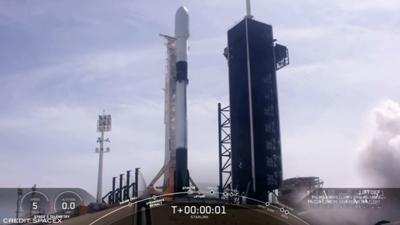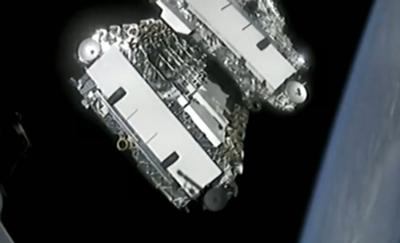Tue, Aug 18, 2020
Booster Will Be Flown (And Hopefully Recovered) For SIXTH Time
SpaceX is targeting Tuesday, August 18 at 10:31 a.m. EDT for launch of its eleventh Starlink mission, which will include 58 Starlink satellites and three of Planet's SkySats.

Falcon 9 will lift off from Space Launch Complex 40 (SLC-40) at Cape Canaveral Air Force Station in Florida. Falcon 9’s first stage previously supported the Telstar 18 VANTAGE mission in September 2018, the Iridium-8 mission in January 2019, and three separate Starlink missions in May 2019, January 2020, and June 2020.
Following stage separation, SpaceX will land Falcon 9’s first stage on the “Of Course I Still Love You” droneship, which will be stationed in the Atlantic Ocean. Falcon 9’s fairing previously flew on the fourth launch of Starlink. Planet’s SkySats will deploy sequentially beginning about 12 and a half minutes after liftoff, and the Starlink satellites will deploy approximately 46 minutes after liftoff.
This will reportedly be SpaceX’s 99th mission (and 92nd use of a Falcon 9) and the booster being used will hopefully be the first booster to have successfully launched and landed 6 times!!!

With performance that is expected to surpass that of traditional satellite internet, and a global network unbounded by ground infrastructure limitations, Starlink may soon deliver high speed broadband internet to locations where access has been unreliable, expensive, or completely unavailable. Starlink is targeting service in the Northern US and Canada in 2020, rapidly expanding to near global coverage of the populated world by 2021.
Starlink is also claiming to be on the leading edge of on-orbit debris mitigation, meeting or exceeding all regulatory and industry standards. At end of life, the satellites will utilize their on-board propulsion system to deorbit over the course of a few months. In the unlikely event the propulsion system becomes inoperable, the satellites will burn up in Earth’s atmosphere within 1-5 years, significantly less than the hundreds or thousands of years required at higher altitudes.
More News
Charted Visual Flight Procedure Approach An approach conducted while operating on an instrument flight rules (IFR) flight plan which authorizes the pilot of an aircraft to proceed >[...]
“When l became the Secretary of Defense, I committed to rebuild our military to match threats to capabilities. Drones are the biggest battlefield innovation in a generation, >[...]
Aero Linx: Stearman Restorers Association Welcome to the Stearman Restorers Association. The Stearman Restorers Association is an independent “Not for Profit” 501C-3 Co>[...]
Airplane Exhibited A Partial Loss Of Engine Power When It Was About Halfway Down The Runway Analysis: The pilot of the experimental amateur-built airplane was departing from his pr>[...]
The Flight Path Was Consistent With Low-Altitude Maneuvering On June 18, 2025, about 0922 mountain standard time, a Cessna A150L airplane, N6436F, was substantially damaged when it>[...]
 ANN's Daily Aero-Term (07.15.25): Charted Visual Flight Procedure Approach
ANN's Daily Aero-Term (07.15.25): Charted Visual Flight Procedure Approach Aero-News: Quote of the Day (07.15.25)
Aero-News: Quote of the Day (07.15.25) ANN's Daily Aero-Linx (07.15.25)
ANN's Daily Aero-Linx (07.15.25) NTSB Final Report: Kjelsrud Gary Kitfox
NTSB Final Report: Kjelsrud Gary Kitfox NTSB Prelim: Cessna A150L
NTSB Prelim: Cessna A150L




